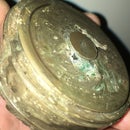Introduction: Grow Miniature Coral From Calcium Acetate
My previous instructable was making Calcium Acetate from Chalk & Vinegar, which was a success when making gelled ethanol. I then had an idea, I have grown the odd crystal over the years and decided to try out some of my Calcium Acetate........it work a treat!!!!
Step 1: Tools and Substrate
Calcium Acetate is available online or instructions for making it, are on Instructables -
I actually dissolved the ashes of my Californian snowball in vinegar (Carbonate with Traces of Carbon) just to recharge and not waste what I already had - I then filtered this and boiled it down, so it was concentrated but not a saturated solution.....
If you start from scratch dissolve 15g in 75mls of water, now filter the solution to get rid of solid matter.
Take a small, reasonable clean piece of chalk, not covered in mud. My piece was about 1x1/2x1/2" , Your piece can be any shape of your choice.
Then place chalk in a clean shallow breakfast bowl
Take a piece of foil slightly bigger than your bowl, fold in half and then half again. Do not crease too hard it's only to find the centre, now tear out a small quadrant, roughly an inch, then unfold.
This serves as a dust and evaporation shield for your substrate. Use the images as a guide...
Step 2: Construction of Crystal Environment
Now we have a piece of chalk, a bowl, foil shield and some Calcium Acetate solution. Place piece of chalk as you wish to see it, a nice ridge with a rough edge is a great growth site.
Now pour acetate solution over the chalk and place foil square over the sample like in image, fold four corners down the sides of the bowl, aligning the central hole with your substrate/ chalk in the centre....
The reason I made a shield was to slow down the loss of solution through evaporation as I wanted to the majority of evaporation to happen via the substrate. It also reduces dust collecting above the solution....
Now just leave in an undisturbed place and be very patient ;-)
On the first day: you should have a furry rock, especially on the edges.
After three days: definition and some spikes, but very very small.
After one week you should have what you see in the image (2) above, with prominent spikes.
After nearly 10 days you should see very well established branches forming......see the last image..it is still growing and 8-9 mm high and resembling a miniature forest....
Step 3: Explanation
The substrate that the crystal is growing on is porous, so it acts like a wick, as the rock becomes moist, evaporation starts to occur. This soon becomes an ideal nucleation site for crystal growth.
If you look at some caves you see calcium sulphate acts the same, this is how stalactites and stalagmites are formed.
Also the crystal cave in Mexico is a fantastic example of crystal growth The main chamber contains giant selenite crystals (gypsum, CaSO4·2) a must see!!!!
http://news.nationalgeographic.com/news/2010/10/101007-lost-crystal-caves-mexico-science-mine-superman-ice-palace/
Please Rate & Comment ?
Step 4: Gallery
As you can see it has grown a lot since the beginning - it resembles a hedgehog also ....... I G













